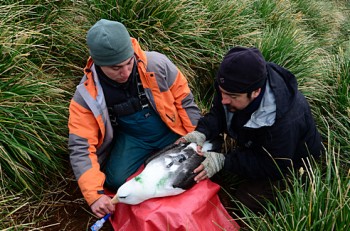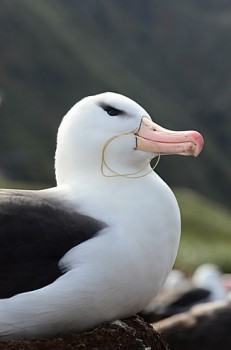
The Chilean Islas Diego Ramírez lie at the southern tip of the South American continental shelf in the northern reaches of the Drake Passage. The archipelago comprises various islands and rock stacks arranged in northern and southern groups, separated by several kilometres. They are uninhabited save for a weather station operated by the Chilean Navy on Isla Gonzalo since 1957 and are free of introduced predators. The most prominent islands are Isla Gonzalo (33 ha; large island in the foreground), Isla Bartolomé (67 ha; large island above Gonzalo) and Islote Ester (hummock-shaped island to the right). The northern group of islets is visible near the horizon at the top left of the photo. At 56° 31’S Diego Ramírez is the southern-most mollymawk albatross breeding site in the World and has been identified as an Important Bird Area. Much of the islands are covered by Tussock Grass Parodiochloa flabellata.

Islas Diego Ramírez holds globally important populations of Vulnerable Grey-headed Albatrosses Thalassarche chrysostoma. The archipelago holds c. 23% (c. 17 000 annual pairs) of global numbers, the largest after South Georgia (Islas Georgia del Sur)*. Together, South Georgia (Islas Georgia del Sur)* and Diego Ramírez hold c. 85% of the World population of Grey-headed Albatrosses.

Diego Ramírez also supports 55 000 pairs of Endangered Black-browed Albatrosses T. melanophris, the largest population of this species in Chile. Black-browed Albatrosses are killed incidentally in local longline and trawl fisheries, especially the longline fishery for Patagonian Toothfish Dissostichus eleginoides. In 2002 an estimated 1500 Black-browed Albatrosses were taken incidentally by this fishery. This number dropped to zero in 2008 due to a change in fishing practice from the traditional Spanish system to the Chilean method of longlining. As a consequence the Diego Ramírez Black-browed Albatross population has recently shown signs of recovery.

Black-browed and Grey-headed Albatrosses on Diego Ramírez have been the subject of tracking studies to determine foraging ranges and overlaps with local fisheries. Here researchers Victor Raimilla and Cristian Suazo deploy a remote-sensing device on a Black-browed Albatross (click here for news of their recent research).

A Black-browed Albatross on Diego Ramírez shows evidence of having swallowed a hook and then been cut free from a longline
Photographs by Graham Robertson
The island group may also support ACAP-listed Southern Giant Petrels Macronectes giganteus, with three species of burrowing petrels confirmed, including the Sooty Shearwater Puffinus griseus.
Selected References:
Arata, J. & Xavier, J.C. 2003. The diet of black-browed albatrosss at the Diego Ramirez Islands, Chile. Polar Biology 26: 638-647.
Lawton, K., Robertson, G. Kirkwood, R., Valencia, J., Schlatter, R. & Smith, D. 2006. An estimate of population sizes of burrowing seabirds at the Diego Ramirez archipelago, Chile, using distance sampling and burrow-scoping. Polar Biology 29: 229-238.
Moreno C.A. & Robertson, G. 2008. ¿Cuántos albatros de ceja negra, Thalassarche melanophrys (Temminck, 1828) anidan en Chile? Anales del Instituto de la Patagonia, Chile 36: 89-91.
Moreno C.A., Arata, J.A., Rubilar, P., Hucke-Gaete, R. & Robertson, G. 2006. Artisanal longline fisheries in Southern Chile: lessons to be learned to avoid incidental seabird mortality. Biological Conservation 127: 27-36.
Moreno C.A., Castro, R., Mújica, L.J. & Reyes, P. 2008. Significant conservation benefits obtained from the use of a new fishing gear in the Chilean Industrial Patagonian Toothfish Fishery. CCAMLR Science 15: 79-91.
Robertson, G., Moreno, C.A., Gutiérrez, E., Candy, S.G., Melvin, E.F. & Seco Pon, J.P. 2008. Line weights of constant mass (and sink rates) for Spanish-system Patagonian toothfish longline vessels. CCAMLR Science 15: 93-106.
Robertson, G., Moreno, C.A., Lawton, K., Arata, J., Valencia, J. & Kirkwood, R. 2007. An estimate of the population sizes of Black-browed (Thalassarche melanophrys) and Grey-headed (T. chrysostoma) Albatrosses breeding in the Diego Ramírez Archipelago, Chile. Emu 107: 239-244.
Valencia, J. 1995. Conservation status of the Archipelago Diego Ramirez. In: Dingwall, P.R. (Eds). Progress in Conservation of the Subantarctic Islands. Proceedings of the SCAR/IUCN Workshop on Protection, Research and Management of Subantarctic Islands, Paimpont, France, 27-29 April, 1992. Gland: IUCN. pp. 107-112.
Cristian Suazo, Carlos Moreno & Graham Robertson, 19 March 2013
*A dispute exists between the Governments of Argentina and the United Kingdom of Great Britain and Northern Ireland concerning sovereignty over the Falkland Islands (Islas Malvinas), South Georgia and the South Sandwich Islands (Islas Georgias del Sur y Islas
Sandwich del Sur) and the surrounding maritime areas.

 English
English  Français
Français  Español
Español